May 30, 2008
Air Date: May 30, 2008
FULL SHOW
SEGMENTS
Power Play on Climate Bill
/ Jeff YoungView the page for this story
A global warming bill before the U.S. Senate splits the once monolithic electric utility industry. Now it's coal-burning companies vs. cleaner energy users. But does division in the industry ranks make a climate change law any more likely? Living on Earth’s Jeff Young reports from Capitol Hill. (06:00)
Calculating the Costs of Cutting Carbon
View the page for this story
The potential costs of limiting carbon dioxide emissions are playing a big part in the debate on the climate bill. While some economists say capping carbon will cost jobs, others disagree. Host Bruce Gellerman talks with economist Janet Peace from the Pew Center on Global Climate Change about the costs - and benefits - of climate change legislation. (06:00)
Lead and Violent Crime
/ Ashley AhearnView the page for this story
For the past three decades, researchers from the University of Cincinnati have been following 240 people from largely African American neighborhoods of Cincinnati with high lead contamination. With each passing year, more is revealed about how lead in the environment affects health and behavior. Now, new research reveals that, even at low levels, lead exposure in early development shrinks key areas of the brain, and is also linked with violent crime. Living on Earth’s Ashley Ahearn traveled to Cincinnati and has our story. (06:45)
Carbon Free City in an Oil Oasis
View the page for this story
The United Arab Emirates is building a city that designers say will be carbon-neutral and waste-free. Host Bruce Gellerman talks with Sultan Ahmed Al Jaber, the CEO of the Masdar Project, about how a community powered by renewable energy is emerging on the coast of one of the world's major oil producers. (05:30)
Questionable Credits
View the page for this story
A Stanford team of researchers finds many credit-for-cleanup projects in developing countries under the Kyoto agreement would have happened without the credits, and that means no net improvement for the Earth's atmosphere. (05:30)
Cool Fix for a Hot Planet
/ Annie JiaView the page for this story
Dutch scientists have figured out how to harness the sun as it beats down on hot highways - cutting heating and road repair bills. Annie Jia reports. (01:45)
Cycling to the Bottom of the World
View the page for this story
Some folks travel to the world’s highest mountaintops. But Jim Malusa decided to do the opposite. Over a period of six years, Malusa biked his way to the lowest points on the face of the planet. A botanist, Malusa started in Australia and pedaled to what he calls “anti-summits” in Patagonia, Africa, as well as to Death Valley and the Dead Sea. Jim Malusa chronicles his adventures in the book, “Into Thick Air: Biking to the Bellybutton of Six Continents” and spoke with host Bruce Gellerman. (07:20)
Eco Elvis
View the page for this story
Eco Elvis is alive and well in Kansas City, Missouri. He’s recycled a dozen of his favorite songs to address environmental issues and performs for audiences of all ages. His alter ego, Matt Riggs, talks with host Bruce Gellerman. (08:20)
Show Credits and Funders
Show Transcript
HOST: Bruce Gellerman
GUESTS: Sultan Ahmed Al Jaber, Jim Malusa, Janet Peace, Matt Riggs, Michael Wara REPORTERS: Ashley Ahearn, Jeff Young
[THEME]
GELLERMAN: From Public Radio International - this is Living on Earth.
[THEME]
GELLERMAN: I’m Bruce Gellerman. A new study links even low levels of lead in children to arrests for violent behavior as adults.
LAQUISHA: I was kickin’ and screamin’ – and I was hitting him with my handcuff that was free, and then somehow he got me in a headlock. At that point in time I just wasn’t thinking.
GELLERMAN: Also, the political climate changes on Capitol Hill as Congress takes up global warming. And the king is dead – long live Eco-Elvis.
RIGGS: ‘I Want You, I Need You, I Love You’ is the song that’s based on, and I just was thinking, ‘hmm, that’s got three words and “reduce, reuse, recycle” is three words,’ and it just – it went from there.
[MUSIC: Eco-Elvis “I reduce, I reuse, I recycle” from 'Burnin' Globe’ (Matt Riggs – 2006)]
GELLERMAN: Stick around!
ANNOUNCER: Support for Living on Earth comes from the National Science Foundation and Stonyfield Farm.
[RETURN THEME]
Power Play on Climate Bill
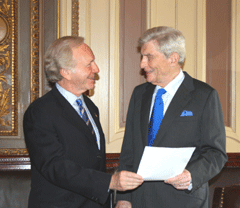
Senators Lieberman and Warner drafted the climate change bill. (Courtesy of the U.S. Congress)
GELLERMAN: From the Jennifer and Ted Stanley Studios in Somerville, Massachusetts – this is Living on Earth. I’m Bruce Gellerman in for Steve Curwood. The climate on Capitol Hill is heating up as Congress begins debating a bill to deal with global warming. Republican Senator John Warner of Virginia and Independent Joe Lieberman of Connecticut propose what’s called a “cap and trade” system to reduce the emission of greenhouse gases. It’s a complex and comprehensive piece of legislation that could transform the nation’s energy economy. And that has some of the biggest names in the energy business scrambling, sparking a power struggle among power companies. Living on Earth’s Jeff Young reports.
YOUNG: The Warner-Lieberman Climate Security Act faces some pretty long odds. Well-funded, industry lobbies oppose the bill, and even if it does manage to pass Congress it would almost certainly be vetoed by President Bush. Some would say the bill doesn’t have a prayer. Well, Senators Warner and Lieberman had a bishop, a pastor and Rabbi David Saperstein on hand to show that it does.
SAPERSTEIN: It has taken a giant courageous groundbreaking step in addressing the global warming crisis. And we will do what we can to see the success of your efforts. (Murmured thank yous in background)
YOUNG: It will take more than religious support to convert enough senators, though. So Senators Warner and Lieberman tried to ease worries about the potential cost of cutting CO2. The bill lets companies who have a hard time cutting CO2 use more carbon offsets, instead – things like tree planting and other projects that could store carbon. It helps low-income households pay utility bills. And Senator Warner says his bill would let the president alter the carbon trading system if energy prices went too high.
WARNER: But it’s important that the president of the United States have the ability to take that throttle on occasion and bring it back if economic situations dictate that.

Senators Lieberman and Warner drafted the climate change bill.(Courtesy of the U.S. Congress)
[CLUB FOR GROWTH AD: “ This time, they’re pushing massive new taxes and regulation in the name of global warming. But let’s ask ourselves, are the unproven benefits of legislation worth the major job losses, new taxes and increased energy costs that could result?”]
YOUNG: The ad shows scary numbers about lost jobs and energy price spikes. But most economists consider those numbers very unreliable. Even some electric utility companies complained about their own trade group, Edison Electric Institute, making dire predictions of economic catastrophe. Edison Electric commissioned an economic forecast that said capping CO2 emissions would push electricity prices sky high. Eight of Edison Electric’s member companies wrote a testy letter telling Edison to stop using those figures.
Steven Kline is a vice president for one of those companies, Pacific Gas and Electric. Kline says the forecast Edison Electric used did not give very useful data.
KLINE: No, I think that it’s sort of like throwing a dart. We encouraged them to look in a much more robust way at the bill and to think about it a little more broadly, and they were very open to doing that. I still would probably be a bit more optimistic about our ability to do this at lower cost.
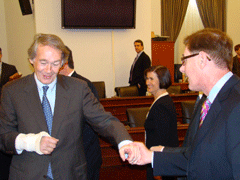
Steven Kline (right) from Pacific Gas & Electric shakes hands with Congressman Edward J. Markey at a May hearing about the role energy companies can play in a carbon-constrained future. (Courtesy of the Select Committee on Energy Independence and Global Warming)
O’DONNELL: So we see a real fissure within the electric power industry where some of the less coal-dependent companies are saying, ‘let’s just do an honest assessment of costs, let’s not jack up the costs.’
YOUNG: That’s Frank O’Donnell with the non-partisan watchdog group Clean Air Watch. O’Donnell says a power company’s position on a climate change bill largely depends on what fuel that company uses. Those that burn more coal are the strongest opponents. Companies like Pacific Gas and Electric tend to support regulation. They use a mix of nuclear, hydropower, natural gas and renewables like wind. O’Donnell says that’s creating a split in an industry that often spoke with one voice against environmental measures.
ODONNELL: Historically they have been a monolith. In this case, some of the disagreements are right out there on the front pages, and I think it’s happening because some of the coal-heavy companies have been very aggressive in pushing their approach, and some of the less coal-dependent companies have decided, we can’t just sit back here and let them run over us. We’re gonna have to speak up for ourselves.
YOUNG: Power company CEO’s are also fighting over the Warner-Lieberman bill‘s system for allocating permits to emit CO2. There’s big money at stake, and Edison Electric spokesperson Dan Riedinger says it’s unlikely his group’s member companies will reach agreement.
RIEDINGER: So companies don’t see eye-to-eye on that. It’s a tough issue, and it’s not one, you know, that we as an industry may be able to take, you know, one position on.
YOUNG: Industry lawyer and lobbyist Scott Segal, of the firm Bracewell and Giuliani, says it’s no surprise that global warming has sharpened divisions in a highly competitive industry.
SEGAL: Climate change has the outward appearance of pitting all of public interest against all of private interest, but that’s actually not right. Lurking below the surface, you find that the private interests all have different and discrete views when it comes to global climate change, and in the course of the debate I think you will hear a lot of these discrete interests teased out and come forward.
YOUNG: So what do these splits within industry mean for global warming legislation? Well, there will be vigorous debate about costs, and there could be a shake-up in the usual dynamic of business versus environment. Insiders say that could help push a climate change bill to passage – sometime. But probably not this bill, and probably not this year.
For Living on Earth, I’m Jeff Young in Washington.
Related links:
- The latest version of the Lieberman Warner bill, with changes intended to reduce costs
- Edison Electric Institute on the Warner Lieberman bill
- An overview of economic forecasts for the Warner Lieberman bill
- Pacific Gas & Electric climate change initiatives
- Clean Air Watch
Calculating the Costs of Cutting Carbon
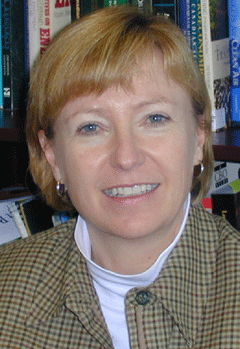
Janet Peace from the Pew Center on Global Climate Change wrote “Insights from Modeling Analyses of the Lieberman-Warner Climate Security Act.” (Courtesy of Janet Peace)
GELLERMAN: So let’s get down to the nitty-gritty. If Congress does pass a bill capping climate- changing gases, what’s it gonna cost you? An ad by the U.S. Chamber of Commerce says if you think you’re gonna get off cheap…
[ALARM BELL]
GELLERMAN: …wake up and smell the coffee. The Chamber predicts a law restricting green house gases will usher in a ‘dark age’ in America, cost consumers trillions, and force 3.4 million of us out of jobs.
[U.S. CHAMBER OF COMMERCE AD: “Climate legislation being considered by Congress could make it too expensive to heat our homes, power our lives, and drive our cars. Is this really how Americans want to live?”]
GELLERMAN: No way. But are these dire predictions based on solid facts? Turns out Congress, the U.S. Chamber and other interest groups rely on about a dozen economic models to forecast the future. These models are designed by private companies, think tanks and governmental agencies. They’re complex, and according to Janet Peace, misused. She’s the Senior Economist with the Pew Center on Global Climate Change and she recently analyzed the various economic models. Hi Janet!
PEACE: Hi there.
GELLERMAN: How accurate are these models?
PEACE: Well they’re not accurate at all, and I think most people who actually run these models don’t profess that they’re accurate. They’re simplifications on reality, they’re there to give us some insights, but really they’re only as good as the assumptions and the data that you put into them.
GELLERMAN: I’m looking at one from July ’07 that the EPA used in its model, and it found that if the Lieberman-Warner Climate Security Act were made into law, it would raise gas prices by 68 cents per gallon by 2050. I think it went up 68 cents a gallon last week.
PEACE: And it’s gone up a lot more than that over the last year and a half. The models – they’re not crystal balls. They’re not gonna give you the exact answer. I mean how can we expect a model to forecast what technology’s gonna be 50 years out. I mean 20 years ago I wouldn’t have envisioned that I’d have a little computer that goes in my pocket. And so models are very good at looking backwards, but they’re not very good at anticipating surprises or new technology.
GELLERMAN: Or price of gasoline. If it can’t tell you what the price of gasoline is next week, how is it gonna do it in 2050?

Janet Peace from the Pew Center on Global Climate Change wrote “Insights from Modeling Analyses of the Lieberman-Warner Climate Security Act.” (Courtesy of Janet Peace)
GELLERMAN: So they’re like rearview mirrors – that they’re looking back, and then they’re projecting forward. But I’m looking at the report by the National Association of Manufacturers and the American Council for Capital Formation – they have a model that assumes that the amount of wind power that we’ll be producing in 2030 is going to be less than what we produced last year.
PEACE: Right, and if you think that well, maybe we’ve maxed out the number of sites for wind generation, that’s what you put into that model. But you have to realize that last year we didn’t have a climate policy, and we’re assuming that there will be a climate policy 50 years out. So I think it’s pretty unrealistic to assume that we’re not gonna have more, you know, low-carbon energy available when we have a policy that actually promotes that and streamlines it. And there are those who say well, we don’t have the technology to get us to where we need to go to. That’s frankly not accurate.
You know, one of the studies that we did at the Pew Center was looking at how to get technology deployed, and we found that it’s more cost-effective, it’s cheaper if you can give incentives and give firms a reason to use that technology, rather than doing just, you know, incentives or mandatory controls. It’s about ten times cheaper to do both than it is to do one or the other.
GELLERMAN: Well these models all seem to have dire consequences in terms of jobs, GDP, the prices of things, but they’re only looking, it seems to me, at the cost, not the benefits.
PEACE: (laughs) None of the models include the benefits. The benefits side of the story is probably the least studied of this whole question. But for the most part, I think people – at least the folks that I deal with – tend to agree that there’s no doubt that the costs of inaction are expected to be widely, or much higher, than the cost of taking action. With more and more warming, you know, you lose beaches, you have to change the infrastructure. There are increased wildfire in some places, decreased water in other places. But it’s inherently more difficult to figure out what the cost of an environmental impact is than it is the cost of a climate policy.
GELLERMAN: Or the benefit of a climate policy.
PEACE: Mm-hmm. Yeah –
GELLERMAN: I mean, there could be more jobs; there could be bigger GDP. Prices on some things could go down.
PEACE: And some of the models actually, you know, suggest that – that, you know, we put all these energy efficiency measure in, and people become more efficient and there’s lower demand for electricity, and the price of electricity goes down. So that’s the result in some of the models. But none of the models do benefits’ side very well. And I think that’s a really important thing to keep in mind, that without thinking about the benefits, any policy is gonna be too expensive.
GELLERMAN: So what are the insights that we can glean from these models, taken as a whole?
PEACE: Well, dealing with this climate issue, I think inherently has some costs associated with it, at least in the near term, because we’ve got to figure out different ways of doing what we’ve been doing for a long time. But over the longer term, you know, we may be putting ourselves in a competitive position; we may be creating new technologies that we can export around the world. So there are a lot of positives, and the insight from all the models is that the economy is gonna continue to grow, but it’s gonna cost a lot more if we can’t get that technology out there.
GELLERMAN: Janet Peace is the Senior Economist with the Pew Center on Global Climate Change. Ms. Peace, thank you very much.
PEACE: My pleasure.
Related link:
To learn more about Janet Peace’s analysis, click here
[MUSIC: John Ellis “Trash Bash” from Dance Like There’s No Tomorrow (Hyena Records 2008)]
GELLERMAN: Coming up – it’s been banned for 30 years, but lead paint continues to devastate communities and kids. That’s straight ahead on Living on Earth.
Lead and Violent Crime

MRI images reveal volume loss in regions of the brain responsible for decision making, reasoning and judgement in people exposed to lead during early development. (photo: University of Cincinnati, Cincinnati Children's Hospital)
GELLERMAN: It’s Living on Earth. I’m Bruce Gellerman. Recent reports about lead in toys have raised fears and renewed concerns about what it does to our children. We’ve known for years that lead is a neurotoxin. That it can lower a child’s IQ, lead to behavioral problems and cause Attention Deficit Hyperactivity Disorder. But lead in toys isn’t the main problem; it’s lead-based paint in old homes that causes the most harm in kids.
That’s why for the past three decades, researchers at the University of Cincinnati and Cincinnati Children's Hospital have been studying a group of people – mostly African Americans – who live in poor neighborhoods contaminated with lead. What the researchers have discovered is that exposure to lead, even at low doses, reduces the size of developing brains, and when kids grow up they’re more prone to commit violent crimes. We have this report from Living on Earth's Ashley Ahearn.
[MRI MACHINE TICKING NOISE]
AHEARN: At Children’s Hospital in Cincinnati, Damon lies inside the giant white cylinder of an MRI machine as it takes thousands of pictures of his brain.
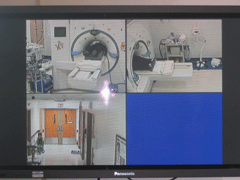
The MRI machine at Cincinnati Children’s Hospital takes thousands of pictures of Damon’s brain to find out what parts are affected by lead exposure.
(photo: Ashley Ahearn)
AHEARN: How’d it go in there?
DAMON: Good.
AHEARN: Good? Did you fall asleep?
DAMON: Yeah, for probably about a minute or so. I was tryin’. I was real tired.
AHEARN: At 28 years old, Damon is one of 240 people with high blood lead levels that researchers at the University of Cincinnati have been monitoring since before they were born.
DAMON: I remember the cab rides, the trips with my mama. It’s just something I been doing since I was a little boy and it continues.
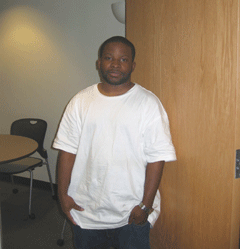
Damon is a participant in the Cincinnati Lead Study, which is linking lead exposure with volume loss in the prefrontal cortex of the brain, especially in men. (photo: Ashley Ahearn)
His lead exposure makes his brain interesting to Kim Cecil, a professor of radiology at the University of Cincinnati. She’s studying the ways lead affects the size and health of the brain – the frontal lobe in particular.
CECIL: The frontal lobe is the part that probably makes us the most human in that it’s executive functioning, attention, inhibition, reasoning, judgment, kind of overall control.
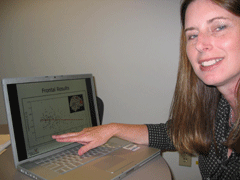
Kim Cecil, Professor of Radiology at the University of Cincinnati shows the correlation between lead exposure and brain volume loss. She says lead acts like calcium in the brain, preventing the maintenance of healthy neurons.
(photo: Ashley Ahearn)
CECIL: It reduces a lot of special receptors, it interferes with many enzymes that preserve the neurons in the brain, so it stops the healthy maintenance of neurons and then neurons can die.
AHEARN: What does that look like? If you were to open up a skull of someone who had a really high lead exposure level, what would I see?
CECIL: Atrophy. And it looks like a shriveled up brain. So in a way it looks like a person who’s much, much older.
AHEARN: Young men like Damon show more volume loss to the frontal lobe than young women exposed to similar levels of lead. Cecil published her findings in the most recent issue of the Public Library of Science Medicine.
Other new research on the same group of study participants shows that even at levels well below government standards, lead exposure during early development may be linked to criminal arrests in young adulthood.
Kim Dietrich is a Professor of Environmental Health at the University of Cincinnati and co-author of the study.
DIETRICH: What we found was interesting. The most robust and significant associations were between early exposure to lead and arrests involving violent acts – some sort of violent aggressive behavior.
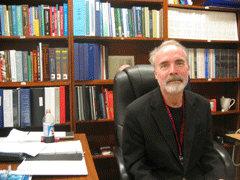
Kim Dietrich, Professor of Environmental Health at the University of Cincinnati, has been working with the lead study participants for almost thirty years. Dietrich's new findings link lead exposure and violent crime. (photo: Ashley Ahearn)
AHEARN: Violent, impulsive acts – the kind of behavior that might result from damage to the part of the brain responsible for self-restraint and decision-making.
Dietrich’s team found that for every increase of five micrograms per deciliter of lead in a child’s blood, there was a 30 percent rise in their arrests for violent offenses.
And because male and female brains develop differently in the womb, the research suggests male brains are more vulnerable to lead. But females are not immune.
[SOUND OF RAIN; FRONT DOOR OPENING; WOMAN SAYING “HI MISS ASHLEY, HOW YOU DOIN’?”; DOOR CLOSES; AHEARN SAYING “I’M GOOD; A LITTLE WET”]
AHEARN: It’s pouring rain when I get to Laquisha’s place in Northern Cincinnati. Music blares as she welcomes me in.
[HIP HOP PLAYING]
AHEARN: Laquisha’s 23 and she’s been participating in the lead study since she was about a year old. She says, looking back, she can see how lead has affected her behavior.

Laquisha (center) with co-workers at McDonalds. She has been participating in the Cincinnati Lead Study since she was a year old and says lead exposure has affected her behavior, with some serious consequences.(photo: Ashley Ahearn)
LAQUISHA: Like, when I was young, when I couldn’t get my way, I, like, tear down the whole bedroom. I break mirrors and everything, I’d pull my hair out and then at the end I be wishin’ I never did it all.
AHEARN: Laquisha’s expressive brown eyes look away as she tells me about another time when her temper got her into trouble. She was at an Arby’s restaurant a few years ago when her boyfriend got in a fight with the girl behind the counter.
Laquisha says she was trying to pull him away when two cops, who were eating there, got involved. When they tried to arrest her, Laquisha lost it.
LAQUISHA: And I was goin crazy, I was kickin, screamin’. I wouldn’t let him get the other handcuff on me so he slammed me and came down with his knee on my stomach so I grabbed his belt and the collar of his shirt and I flipped him on his head. And I was hitting him with my handcuff that was free and then somehow he got me in a headlock. He was punching me in my head, we was just exchangin’. At that point in time I just wasn’t thinkin’.
AHEARN: Laquisha spent two years in jail for her crime, and she takes full responsibility for her actions.
She’s working at McDonald’s now, and trying to pass her GED. But she says she has a tough time focusing.
There’s no doubt in her mind that lead played a part in her violent actions.
[DOOR OPENING; KEYS JANGLING; MAN SAYS “HOW YOU DOIN’ OFFICER?”]
AHEARN: At the Cincinnati Police Department, S. Gregory Baker is director of community relations. He’s familiar with the lead study, and isn’t surprised there’s a link between lead exposure and violent crime.
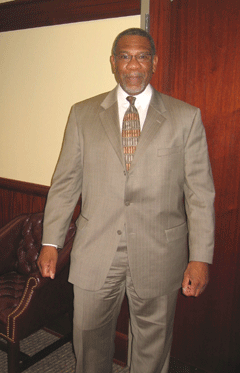
S. Gregory Baker, Director of Community Relations at the Cincinnati Police Department, says officers on duty can’t tell if someone has been exposed to lead, even if it may be partially causing them to commit violent acts of crime.
(photo: Ashley Ahearn)
BAKER: We’ve seen that a lot of these homicides are very impulsive, that they’re not necessarily pre-meditated. They’re what you and I would probably think really wouldn’t merit shooting and killing somebody.
AHEARN: But Baker says when you arrest someone, there’s no way of knowing if lead exposure is affecting their behavior.
BAKER: I mean that’s just not something that we would deal with as far as they had high lead. I think it’s just the causative piece. I mean there really is nothing tangible for us to do about that.
AHEARN: The effects of lead exposure are intangible, although the findings of the team at the University of Cincinnati are changing that.
Kim Dietrich says discovering a link between lead and violent crime doesn’t justify the behavior, but it does help us better understand where it might be coming from.
DIETRICH: The community that these children are growing up in, and these adults are living in, provide many opportunities to engage in criminal behavior. And in some cases lead is pulling the trigger or resulting in the final aggressive act.
AHEARN: For Living on Earth, I’m Ashley Ahearn in Cincinnati, Ohio.
Related links:
- Kim Dietrich’s study “Associations of Prenatal and Childhood Blood Level Concentrations with Criminal Arrests in Early Adulthood.”
- Kim Cecil’s study: “Decreased Brain Volume in Adults with Childhood Lead Exposure.”
- Cincinnati Children’s Environmental Health Center
[MUSIC: DJ Spooky/DJ Logic “Michele” from ‘Under the Influence: Mixed by DJ Spooky, the Subliminal Kid’ (Six Degrees – 2001)]
Carbon Free City in an Oil Oasis

Inside the futuristic city. (Courtesy of the Masdar Initiative)
GELLERMAN: The United Arab Emirates is very good at defying nature. In oil-rich Abu Dhabi, the capital of U.A.E., temperatures can sizzle to a sweltering 104 degrees Fahrenheit, but you can ski on snow year round – indoors. And in Dubai, they’re building artificial islands. But the U.A.E.’s most ambitious project is designed to work with nature.
[PROMOTIONAL VIDEO VOICEOVER: “Imagine, imagine a place where the challenge of living in an extreme climate is overcome at no cost to the environment. Imagine a place of the future with all of the benefits of twenty-first century living, yet none of the stresses of out-dated twentieth century cities.”]
GELLERMAN: Imagine a two point three square mile planned community with 40,000 inhabitants that produces zero carbon emissions and zero waste.
[PROMOTIONAL VIDEO VOICEOVER: “Imagine Masdar!”]
GELLERMAN: The first phase of Masdar City is set to open in 2010. Dr. Sultan Ahmed Al Jaber is CEO of the project.
AL JABER: Masdar means the source. What we're doing is that we're providing the new source of energy.

Caption: An illustration of what the carbon-free Masdar City would look like. (Courtesy of the Masdar Initiative)
AL JABER: We believe it's a logical step. It's clear that Abu Dhabi has been a global player in the energy sector. What we know is in order for us to keep up with the energy demands around the world and maintain the growth that's happening around the world, we will need to come up with new energy sources. Hydrocarbons will be one of those sources, but we need to come up with new, different, clean solutions that will have no impact on our environment.
GELLERMAN: I was looking online – you have a video of the plan for the city:
[POMOTIONAL VIDEO VOICEOVER: “Organically based systems combined with solar and wind collectors balance carbon emissions and reduce the inhabitants' carbon footprint.”]
GELLERMAN: It’s supposed to be carbon neutral –
AL JABER: Yeah.
GELLERMAN: - and energy positive.
AL JABER: Right.
GELLERMAN: The city’s actually going to produce more energy than it uses.
AL JABER: We’re raising the bar very high. We’re trying to make a statement. We’re trying to make the city become a model of sustainable living, and our ultimate goal here is to have the city replicated and transferred elsewhere around the world. We’re targeting for the whole city to have a neutral balance of CO2, as well as zero waste and for the whole city to be fully powered by renewable energy.

Caption – Inside the futuristic city.
(Courtesy of the Masdar Initiative)
AL JABER: Mainly solar: solar thermal and solar photovoltaics. We’re also going to be producing power from the wind. But what you need to know is that if the city was to be built in the conventional way that cities are being built today, the city would require a minimum of 850 megawatts to power up the whole city. But because of the master plans we put together and because of the energy efficiency measures that we are putting in place, we were able to reduce the energy requirements for the whole city from 850 to 220 megawatts.
GELLERMAN: Wow!
AL JABER: So we're talking about –
GELLERMAN: Seventy....
AL JABER: …seventy, seventy-five percent reduction in energy requirements.
GELLERMAN: So you'll be using very advanced technologies and very modern designs?
AL JABER: Definitely.
GELLERMAN: You're going to have cars?
AL JABER: No cars are allowed within the city. The city is being built on a podium – on a platform. All the infrastructure and the transportation infrastructure will be built underneath the podium. There will be a light rail that will be connecting the Masdar City to the airport and to the downtown Abu Dhabi. There will also be personalized electric vehicles that can be driven within the city.
GELLERMAN: Personal...?
AL JABER: Rapid transport
GELLERMAN: Little electric cars.
AL JABER: Yes.
[POMOTIONAL VIDEO VOICEOVER: “Enjoying your morning coffee on a rooftop garden in the calm of a car-free environment, and getting to work in minutes by your personal rapid transport pod. This PRT network provides door-to-door comfortable travel, whatever your destination.”]
GELLERMAN: In the construction of this city, you're going to be using conventional earthmovers and machinery. They're gonna produce carbon dioxide.
AL JABER: We really would like to practice what we preach from day one, but the technology does not permit and allow us to do so from day one. We will always do our best to minimize our carbon footprint from day one. Now, in the construction phase, we need power. This power is not going to be brought from the national grid. We are building our own ten-megawatt photovoltaic power plant, which will power the construction phase. And if there is any carbon that is being produced, we will always make sure that this carbon is being offset.
GELLERMAN: And how much is all this going to cost?
AL JABER: The total development cost for the whole city is 22 billion U.S. dollars.
GELLERMAN: Twenty-two billion?
AL JABER: Yes. Over eight years, and seven phases.
GELLERMAN: Well, so it'll be carbon neutral and energy positive – is it gonna be financially viable?
AL JABER: Yes, it will be financially viable simply because of the new financing mechanisms, such are carbon finance. This city was to be built in a conventional way – how much carbon would this city produce? And by us doing it this way, how much carbon are we actually saving? With that you can actually generate carbon credits that you can trade in the market. And if we are able to do that in many other cities, we will see a great impact on our environment by reducing our carbon emissions, and we'll see a great impact on our energy supplies.
GELLERMAN: Well Dr. Al Jaber, thank you so very much for coming in.
AL JABER: Thank you, thank you.
GELLERMAN: Dr. Sultan Ahmed Al Jaber is CEO of the Masdar City initiative.
Questionable Credits
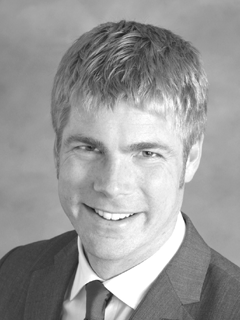
MIchael Wara is a research fellow and lecturer at Stanford Law School. (Courtesy of Stanford University)
GELLERMAN: Now notice what he says about carbon credits: they’re the financial fuel that drives the Persian Gulf eco-paradise, and they’re critical to most plans to offset global green house gases. Okay, your eyes are glazing over, but understanding carbon credits is actually pretty simple.
The carbon credit system was created by the Kyoto Protocol. It’s called the CDM, or Clean Development Mechanism. Here’s how it works: an industrialized country or company producing greenhouse gases can offset its pollution and get credit by bankrolling clean carbon projects in developing nations. Michael Wara of Stanford University’s Program in Energy and Sustainable Development investigated the CDM system.
WARA: What the CDM does is to create a way for – or in theory create a way for – developed world governments and firms to invest in cleaner technology than would have occurred otherwise – push the developing world onto a cleaner development path. That's why they call it the Clean Development Mechanism. Now, this is in theory, and there are a lot of details that have to be worked out to make the theory work in practice.
GELLERMAN: Well how does it work in practice?
WARA: Well our study, and I think the work of many others, suggest that there are a lot of areas where it's not working well.
GELLERMAN: Well, let's take a concrete example.
WARA: Okay.
GELLERMAN: Let's say I'm running a brewery in Vietnam.
WARA: Mm hmm.
GELLERMAN: And I'm creating a lot of heat; I'm using charcoal or diesel fuel, and we're producing a lot of greenhouse emissions. Someone from Europe has a factory and wants to pay us money to convert to a cleaner process.
WARA: Sure.

powerplant_portrero.gif
WARA: Right.
GELLERMAN: Win-win.
WARA: Win-win, in theory. Now, here's the question, though. What other incentives did you, the brewery-owner, have to switch fuels, to switch processes to a cleaner process? Very often, it turns out, there are multiple incentives to make that switch.
GELLERMAN: So without the credits I would have made the switch anyhow.
WARA: Possibly. It's a tough decision that has to be made, and ultimately that decision has to get made for credits to be issued. Someone has to say, this wouldn't have happened without the credits, or, it would have. And that's important for a key reason: these credits go to Europe or other countries that have signed and ratified the Kyoto Protocol, and they're used in lieu of emission reductions within those countries. So the reduction happens in Vietnam, but it doesn't happen in Germany. If the reduction in Vietnam would have happened anyway, then you're not getting the reduction in Germany, and you're not getting the reduction in Vietnam.
GELLERMAN: What percentage of the projects do you think are getting credits that shouldn't get credits?
WARA: Between a third and half of the projects are representing behavior that would have happened anyway – that don't, aren't really real reductions.
GELLERMAN: And you looked at, what, 3,000 projects?
WARA: Yeah, roughly.
GELLERMAN: And half of those shouldn't have been funded.
WARA: Well, this is the hard thing. So let's take a different concrete example. What if you're a wind farm in China. China is becoming one of the largest producers of wind energy in the world. Part of the reason for that is the, is the subsidy provided by the CDM. But we think a much bigger part of the reason is the incentives and subsidies provided by the Chinese government, because they're desperate for electricity right now, and they're especially desperate for clean electricity that doesn't make their citizens sick, like coal-fired power does. So how do you tell, for an individual wind farm, whether it would have been built or not?
GELLERMAN: Well, who does the deciding?
WARA: Well, most of the actual evaluation of projects happens – is done by private third parties that act sort of like a credit-rating agency.
GELLERMAN: But now as I understand it, they're paid for by the companies they're certifying.
WARA: That's right, and that's a real problem in the sense that, you know, these –
GELLERMAN: It's a conflict of interest.
WARA: We believe so, yeah. And one of the reforms that we argue for quite strongly is that that conflict of interest needs to be removed, and that it would improve the quality of the certification and the evaluation of these projects, the evaluation of what would have happened anyway?
GELLERMAN: How big an industry is the CDM's?
WARA: Last year the market was worth about 20 billion dollars.
GELLERMAN: Twenty billion?
WARA: Billion, with a B. But I think the more important thing to focus on is the fact that the market's been doubling or tripling in size every year for the past four years.

Michael Wara says the UN's carbon offset program isn't forcing industrialized nations to cut back on pollution as much as intended. (Photo: Pete Geniella/petegeniella.com)
WARA: Yeah, I think there are some very good examples, where there's really no money to be made in the change in behavior other than the carbon credit. So, things like the capture of methane emissions from landfills and from animal feeding operations. These are places where methane, which is an incredibly potent greenhouse gas – it's about 25 times worse than CO2 – is emitted in large quantities, basically from the decay of organic matter. And it's pretty easy to go in and capture all or most of those emissions. But there's no financial incentive to do so. So the CDM has catalyzed a lot of activity around capturing these emissions, and that's had a really positive impact on greenhouse gas emissions.
GELLERMAN: Well, Michael Wara, thank you very much.
WARA: It's been a pleasure.
GELLERMAN: Talking to us about the carbon credit system is Stanford University’s Michael Wara, co-author of a recent paper investigating the CDM – the Clean Development Mechanism.
Related link:
Stanford Publication
[MUSIC: DJ Logic/Jason Miles “Bollyhood” from ‘Global Noize’ (Shanachie Records – 2008)]
GELLERMAN: Coming up – Eco-Elvis. Get out your green suede shoes. Stay tuned to Living on Earth!
ANNOUNCER: Support for the Environmental Health Desk at Living on Earth comes from the Cedar Tree Foundation. Support also comes from the Richard and Rhoda Goldman fund for coverage of population and the environment. This is Living on Earth on PRI: Public Radio International.
Cool Fix for a Hot Planet

Workers underlay pavement with a network of pipes that will carry water, warmed by the sun, to heat houses in the winter. (Courtesy of Ooms Avenhorn Group)
GELLERMAN: It’s Living on Earth. I’m Bruce Gellerman. Just ahead: pedaling to the pits – biking to the lowest places on earth. But first, this Cool Fix for a Hot Planet from Annie Jia.
[COOL FIX THEME]
JIA: On a hot summer day when the sun’s beating down, some people say, it’s hot enough to fry an egg on the sidewalk.
But a company of civil engineers in Holland has come up with a new, and more practical, way to use the roadway to harness the sun’s heat.

Pavement is laid over the pipes. The warmth retained by the water prevents the surface from freezing in winter, lessening wear and tear on the road.
At nearly a dozen sites across the Netherlands, embedded in the pavement, lies a network of pipes. Water flows through these pipes and heats up in the summer sun. The warm water is then stored underground, where it stays hot for several months.
In the winter, the water is circulated through nearby buildings – homes, industrial complexes, even an airplane hangar – providing warmth.
After it chills, the water is pumped back underground, where it stays cold into the summer. On hot days, the now-chilly liquid provides the same buildings with energy-efficient air conditioning.

Workers underlay pavement with a network of pipes that will carry water, warmed by the sun, to heat houses in the winter. (Courtesy of Ooms Avenhorn Group)
But it’s not just the buildings’ residents who benefit. In fact, this new energy system sprang out of efforts to cut road repair costs. The warm water flowing beneath the road’s surface keeps it from icing over, and so, protects it from the damaging cycles of freezing and thawing.
While the technology remains more costly than conventional heating, its developers believe rising fossil fuel prices will soon render it economical.
That’s this week’s cool – or, hot – fix, for a hot planet. I’m Annie Jia.
Cycling to the Bottom of the World
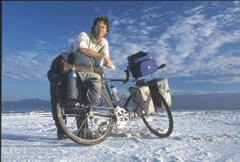
Malusa at Lac Assal, Djibouti- the lowest point in Africa. (Courtesy of Jim Malusa)
GELLERMAN: Many mountaineers aspire to climb the highest peaks on Earth. For Jim Malusa, it's a race to the bottom. In 1996, Malusa, a botanist, hit the road on his bike seeking the lowest points on the planet. He started in Australia and it’s been downhill ever since. Over the next six years he pedaled to Death Valley, the Dead Sea, and the depths in between. Jim Malusa chronicles his adventures in his new book ‘Into Thick Air: Biking to the Bellybutton of Six Continents.’ Jim, welcome to Living on Earth!
MALUSA: Hello! I'm glad to be here.
GELLERMAN: Why the belly button?
MALUSA: Well, it began with a map that my wife and I found in the Times Atlas of the World. There was a place on that map in western China, a green spot, that was called Turpan. And looking closer we discovered it was 500 feet below sea level. We wondered what was going on down there, and chose a route that went through the mountains of Central Asia – Kyrgyzstan and Kazakhstan. And it ends up that it was very cold, and we got very hungry on the way, and by the time we got to Turpan it was an absolute delight to find it filled with watermelons and grapes and friendly folks, and it wasn't too hard to think the pits aren't so bad after all.
GELLERMAN: Are you the only person who's ever traveled by bike to the lowest places on the planet?
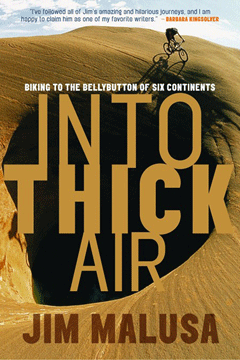
Cover of "Into Thick Air: Biking to the Bellybutton of Six Continents" (Sierra Club Books, 2008)
GELLERMAN: I knew that the Dead Sea was the lowest point on the planet, but I didn't realize that it was the lowest point by a lot compared to the other places. What is it – 1350 feet, is that right?
MALUSA: Yeah, no, you're right. There is – second place is far, far behind. It would be as if Mount Everest at 29,000 feet, and then the second place would be a mere 12,000 feet or so, right. The second lowest point is in Djibouti, there, and Turpan actually – they're around 500 feet below sea level – so Dead Sea is almost three times as deep.
The Caspian Sea is 92 feet below sea level, the shoreline. Salina Grande is about 140 feet, Death Valley 282 feet below sea level, Lake Eyre, Australia is about, oh, 49 feet below sea level.
GELLERMAN: You're a guy who likes to have a beer, a cold one. But along your way, you kind of indulge in local brew. You had, what, yerba mate?

Malusa biking across Australia. (Courtesy of Jim Malusa)
GELLERMAN: (laughs)
MALUSA: He insisted that it's always better with the testicle.
GELLERMAN: Well, I can't attest to that, but (laughs) I'll take his word for it.
MALUSA: (laughs)
GELLERMAN: Well, you also took somebody's word that Salina Grande, which is where you took your bike, was the lowest place in South America – and it wasn't!
MALUSA: Well, what a surprise that was. At that time, the Argentina Institute of Statistics – it was understood to be the low point. Patagonia's a big place and the last ten years they've discovered a place that was lower. After some initial dismay of saying, oh my lord, I've peddled to the wrong low point, now I have a reason to return.
GELLERMAN: When you were planning your trip to Djibouti, people weren't very positive about your going. Who was it, L.M. Nesbit called it the hellhole of creation?
MALUSA: Every tale from Djibouti from earlier in the 1900's has a horrible name, like the hellhole of creation. And the people developed quite an unsavory reputation, simply because of a little habit they had of castrating their enemies. And this has carried over well past the time where this has gone on, and the reputation persists.
And so I was, I suppose the right word would be terrified at first, and then I became less terrified, the more I learned. And once I started talking with people that had been to Djibouti, particularly a Swiss photographer who told me, well, you know, don't worry about the castrators, that's rubbish. There's occasional knife fights or stabbings, but it's not nearly as bad as Detroit, he insisted. And then I called the Djiboutian embassy themselves, and they said, well do you have bicycle experience? And I said, yes, I just rode my bike across Russia. And they said, what about the security in Russia? Isn't it dangerous? So people tend to believe that it's always more dangerous elsewhere.

Malusa at Lac Assal, Djibouti- the lowest point in Africa. (Courtesy of Jim Malusa)
MALUSA: Yes, when I was preparing to go to Djibouti, after I had convinced the embassy that the security in Russia really wasn't that bad, they said well don't worry about Djibouti at all because in the afternoon we'll be chewing the khat. They said it's a stimulant, something like coffee, and we only chew it from maybe one o'clock to around seven.
GELLERMAN: (laughs)
MALUSA: And they said, you won't be worried; you won't feel any stress. And I do like it – it is just what they say. It's a mild stimulant, and the reason I think its popularity is restricted to the Horn of Africa region and also in the Saudi peninsula, is not only because it's a class one offense or something by our own drug association, but because the chemicals that make it such a happy chew almost immediately decompose into the more useless things. And so it has to be – it has to be chewed essentially within a day.
And so Djibouti, a country which is hardly on the cutting edge of technology, and is the kind of country where you spend a lot of time waiting for things to happen, it's something of a miracle to watch khat delivery, okay, which would make FedEx envious. It comes exactly on time, every day, by jet. And then it's delivered by speedboats racing around the country along the coast, and it's quite an organization that they've got set up.
GELLERMAN: Well, Jim, where's your next ride taking you?
MALUSA: When I left Patagonia, I swore I'd never go back because of all the places in the world I went, that was the most rugged in terms of the weather. In the Andes, the wind and the rain, and in the desert, the wind. Now that I'm talking about it, now I'm saying, no I'm not going to do it! (laughs) But perhaps some day I'll get my nerve up and return.
GELLERMAN: Yeah you're making it sound mighty miserable. (laughs)
MALUSA: Well, bicycles can be miserable sometimes. Most of the time they're not. I like to think of them as – they intensify life. They make good times better, and they make bad times worse. You have to accept that if you're gonna go out – that when the conditions are good, boy do you feel good, but when things get bad, you can be stuck for a while too.
GELLERMAN: Well, Jim, thank you very much. I really appreciate you taking the time for us.
MALUSA: Thanks for having me.
GELLERMAN: Jim Malusa's book is called “Into Thick Air: Biking to the Bellybutton of Six Continents.”
Related link:
Jim's website
Eco Elvis

Eco Elvis performs for audiences of all ages.
[MUSIC: Eco-Elvis “Earth Day Rock” from ‘Burnin’ Globe’ (Matt Riggs – 2006)]
GELLERMAN: The king is alive, well – and recycled – in Kansas City, MO.
[MUSIC: Eco-Elvis “Earth Day Rock” from ‘Burnin’ Globe’ (Matt Riggs – 2006)]
GELLERMAN: Eco-Elvis – green sequin jump suit, sideburns and shades – is Matt Riggs, and this is one of the cuts off his CD ‘Burnin’ Globe.’
[MUSIC: Eco-Elvis “Earth Day Rock” from ‘Burnin’ Globe’ (Matt Riggs – 2006)]
Eco Elvis’s disc includes a dozen tunes from the King’s collection of smash hits, retooled with environmental messages. Matt Riggs has entered the building at the studio of KCUR in Kansas City. Matt, it is a real thrill.
RIGGS: (imitating Elvis’ voice) Well thank you very much for having me, man.
GELLERMAN: (laughs) How’d you come up with the inspiration for Eco-Elvis?
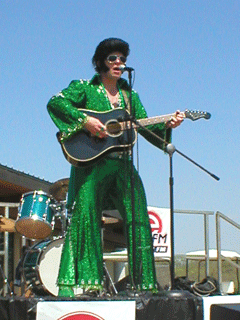
(Courtesy of Matt Riggs)
GELLERMAN: So from those humble origins, a king was born.
RIGGS: That’s right.
[MUSIC: Eco-Elvis “Viva Las Vegans” from ‘Burnin’ Globe’ (Matt Riggs – 2006)]
GELLERMAN: Where do the words come from? Is it hard to make up the words to the tunes?

(Courtesy of Matt Riggs)
GELLERMAN: Well, let’s listen to a little bit of “I Reduce, I Reuse, and I Recycle.”
[MUSIC: Eco-Elvis “I Reduce, I Reuse and I Recycle” from ‘Burnin’ Globe’ (Matt Riggs – 2006): “I use less energy, buy less stuff, use less water, yes it’s tough, I walk or bike instead of taking the car, I reduce, I reuse, I recycle, with all my heart. I eat only what need, on the food chain’s where I feed, baby…”]
GELLERMAN: (laughing) Matt, I’m in tears.
RIGGS: (laughs)
[MUSIC: Eco-Elvis “I Reduce, I Reuse and I Recycle” from ‘Burnin’ Globe’ (Matt Riggs – 2006):
“…I reduce, I reuse, I recycle, more and more, hear me talkin’, baby, hear me talkin’. Well I thought that…”]
GELLERMAN: Your, your outfit – what is it made out of? It looks like an Elvis outfit.
RIGGS: Well, yeah. I try to kind of strike a balance between ecological principles and the need for flash. So part of it’s recycled, like the belt is recycled – it’s an old weight belt turned around, painted green, uh, then I got bottle caps on there, and then I have pop tabs running up and down the seams of the suit. Without the costume I’m about 6’3”, and with – between the hair and the heels on my boots – it’s going, it’s pushin’ seven feet. So it can be quite an intimidating character to enter the room.
GELLERMAN: I like the green Hawaiian lei. That adds a very nice touch.
RIGGS: Yeah (laughs), that classes it up a lot I think.
[MUSIC: Eco-Elvis “Compost Hotel” from ‘Burnin’ Globe’ (Matt Riggs – 2006): “Well...since the landfills are fillin’ up, and yard waste isn’t allowed, a place that used to waste a lot is now compost hotel, well, it’s more friendly baby, it’s more friendly, it gives that garbage a second life, well…”]
GELLERMAN: One of my favorite on the CD is your cover of “Heartbreak Hotel.”
RIGGS: Have you ever visited the compost hotel?
GELLERMAN: (laughs)
RIGGS: That’s a question I always ask my audiences (laughs).
[MUSIC: Eco-Elvis “Compost Hotel” from ‘Burnin’ Globe’ (Matt Riggs – 2006): “Well the kitchen staff started recycling the bread and vegetable scraps, even the paper towels and coffee filters ladies and gentleman – can go to that compost bin out back, well, it’s more friendly, baby…”]

Eco Elvis aka Matt Riggs entertains audiences with environmental messages. (Courtesy of Matt Riggs)
RIGGS: I do, strangely enough (laughs), I mean. I don’t actually think that I am Elvis – there are some people out there that think that I am, and that kind of scares me sometimes, but I – it’s kind of weird, I put that on, and it kind of – you feel that, the power of Elvis kind of come over me – and the confidence he has and the showmanship, and it’s a whole different manner of speaking and acting, and I just kind of totally morph into that character while the costume’s on, so.
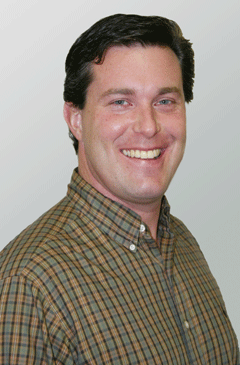
Mild mannered Matt Riggs transforms into Eco Elvis to raise awareness about environmental issues. (Courtesy of Matt Riggs)
RIGGS: (laughs) I think he would probably like it…is my guess. You know he had a lot of problems, but underneath it he was a humanitarian, he was a good person, and I think given today’s dire environmental situation he would probably understand and, you know, say (in Elvis voice) ‘go for it, man!’
GELLERMAN: Well, I want to take it down a notch. Let’s listen to your version of ‘Can’t Help Falling In Love.’
RIGGS: Okay.
[MUSIC: Eco-Elvis “I Can’t Help Recycling It All” from ‘Burnin’ Globe’ (Matt Riggs – 2006): “…but I can’t help recycling it all, it’s true. All creeds say, it is wrong to waste, that’s why I can’t help recycling it all, it’s true. Tiny bits of foil, lids and bottle caps, even post-it notes, I recycle the price-tags off my clothes – yes I do darlin’!”]
GELLERMAN: (laughs) I love that line!
(laughs)
GELLERMAN: (laughing) ‘I recycle the price tags off my clothes.’
[MUSIC: Eco-Elvis “I Can’t Help Recycling It All” from ‘Burnin’ Globe’ (Matt Riggs – 2006)]
GELLERMAN: You know, Matt, it really does have a message.
RIGGS: Mm-hmm. When I started doing Eco-Elvis, it was more to kind of bring excitement to what I thought were kind of dull events. Doesn’t really do much for the cause when people are falling asleep. So I thought, well, Eco-Elvis, you know it’s like, if the flashy costume doesn’t get ‘em the music will, and if the music doesn’t get ‘em the jokes I crack will, and the antics will. So, you know and if that doesn’t get ‘em then the message and the words will get ‘em. So it’s kind of like a, you know, four or five tier punch – if I can’t get ‘em one way, I’ll get ‘em another.
GELLERMAN: Well I’ve always wanted to say this. Matt, (impersonating Elvis’ voice) thank ya, thank ya very much! (laughs)
RIGGS: (in Elvis’ voice) You’re welcome, man. Stop by Graceland sometime. I’ll show ya around baby.
[MUSIC: Eco-Elvis “Let’s Go Organic” from ‘Burnin’ Globe’ (Matt Riggs – 2006): “Let’s go organic, let’s do what’s right, say no to poisons with all your might. In action we’ll seal our fate, let’s go organic, the Earth can’t wait. Few people realize that our health is in danger, our food is tainted by poisons we pay for. They damage our bodies and can even be fatal, farm workers are killed, our children grow ill, so I say….”]
GELLERMAN: Matt Riggs aka Eco-Elvis has left the building. But you can catch a video of the recycled king at our website www.loe.org.
Related links:
- Click here to see a video of Eco Elvis
- Eco Elvis Homepage
GELLERMAN: Living on Earth is produced by the World Media Foundation. Our crew includes Ashley Ahearn, Bobby Bascomb, Eileen Bolinsky, Ingrid Lobet, Helen Palmer, Mitra Taj and Jeff Young, with help from Jennifer Baessler, and Sarah Calkins.
And we say a fond farewell to our interns Annie Jia and Margaret Rossano, who we thank for sharing their energy and creativity. Good luck! Jeff Turton is our technical director. Alison Lirish Dean composed our themes. You can find us at LOE dot org. Steve Curwood is our executive producer. I'm Bruce Gellerman. Thanks for listening!
RIGGS: Well thank ya very much for having me, man.
ANNOUNCER: Funding for Living on Earth comes from the National Science Foundation, supporting coverage of emerging science, and Stonyfield Farm: organic yogurt and smoothies. Stonyfield pays its farmers not to use artificial growth hormones on their cows. Details at stonyfield.com. Support also comes from you our listeners, the Ford Foundation, the Town Creek Foundation, the Oak Foundation supporting coverage of climate change and marine issues and Pax World Mutual Funds: socially and environmentally sustainable investing. Pax World: for tomorrow. On the web at paxworld.com.
ANNOUNCER 2: PRI: Public Radio International.
Living on Earth wants to hear from you!
Living on Earth
62 Calef Highway, Suite 212
Lee, NH 03861
Telephone: 617-287-4121
E-mail: comments@loe.org
Newsletter [Click here]
Donate to Living on Earth!
Living on Earth is an independent media program and relies entirely on contributions from listeners and institutions supporting public service. Please donate now to preserve an independent environmental voice.
NewsletterLiving on Earth offers a weekly delivery of the show's rundown to your mailbox. Sign up for our newsletter today!
 Sailors For The Sea: Be the change you want to sea.
Sailors For The Sea: Be the change you want to sea.
 The Grantham Foundation for the Protection of the Environment: Committed to protecting and improving the health of the global environment.
The Grantham Foundation for the Protection of the Environment: Committed to protecting and improving the health of the global environment.
 Contribute to Living on Earth and receive, as our gift to you, an archival print of one of Mark Seth Lender's extraordinary wildlife photographs. Follow the link to see Mark's current collection of photographs.
Contribute to Living on Earth and receive, as our gift to you, an archival print of one of Mark Seth Lender's extraordinary wildlife photographs. Follow the link to see Mark's current collection of photographs.
 Buy a signed copy of Mark Seth Lender's book Smeagull the Seagull & support Living on Earth
Buy a signed copy of Mark Seth Lender's book Smeagull the Seagull & support Living on Earth

